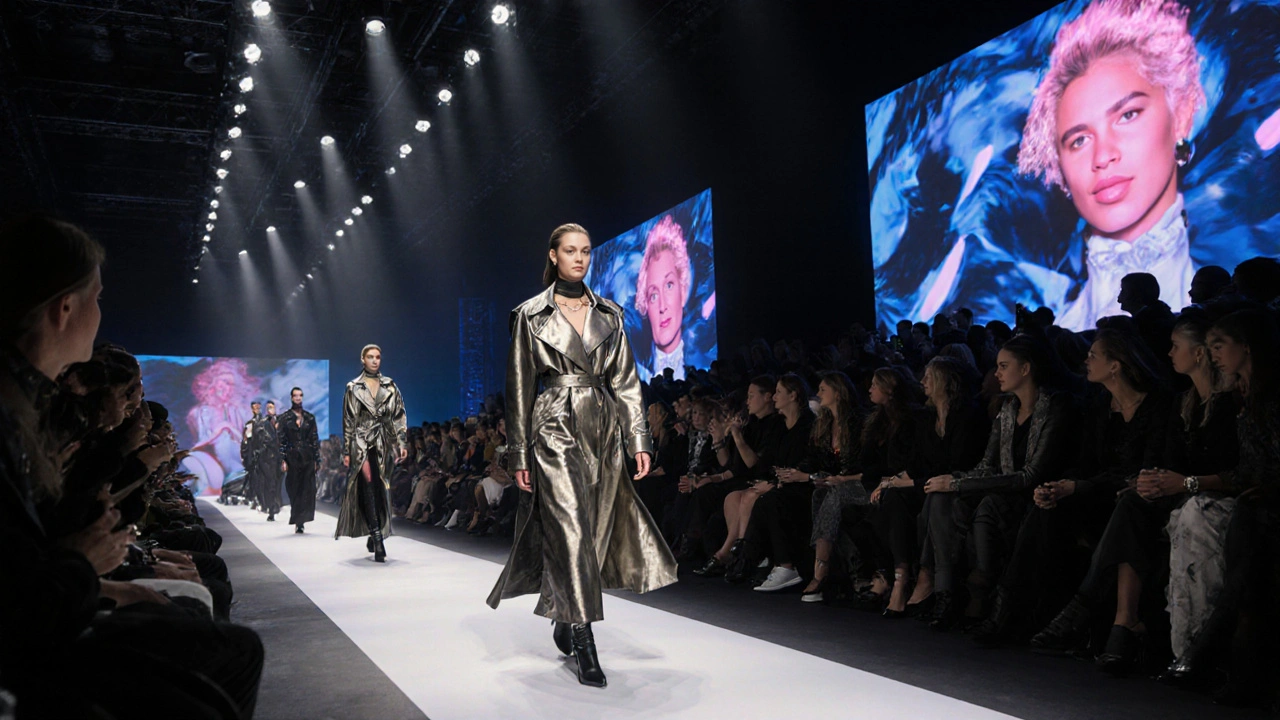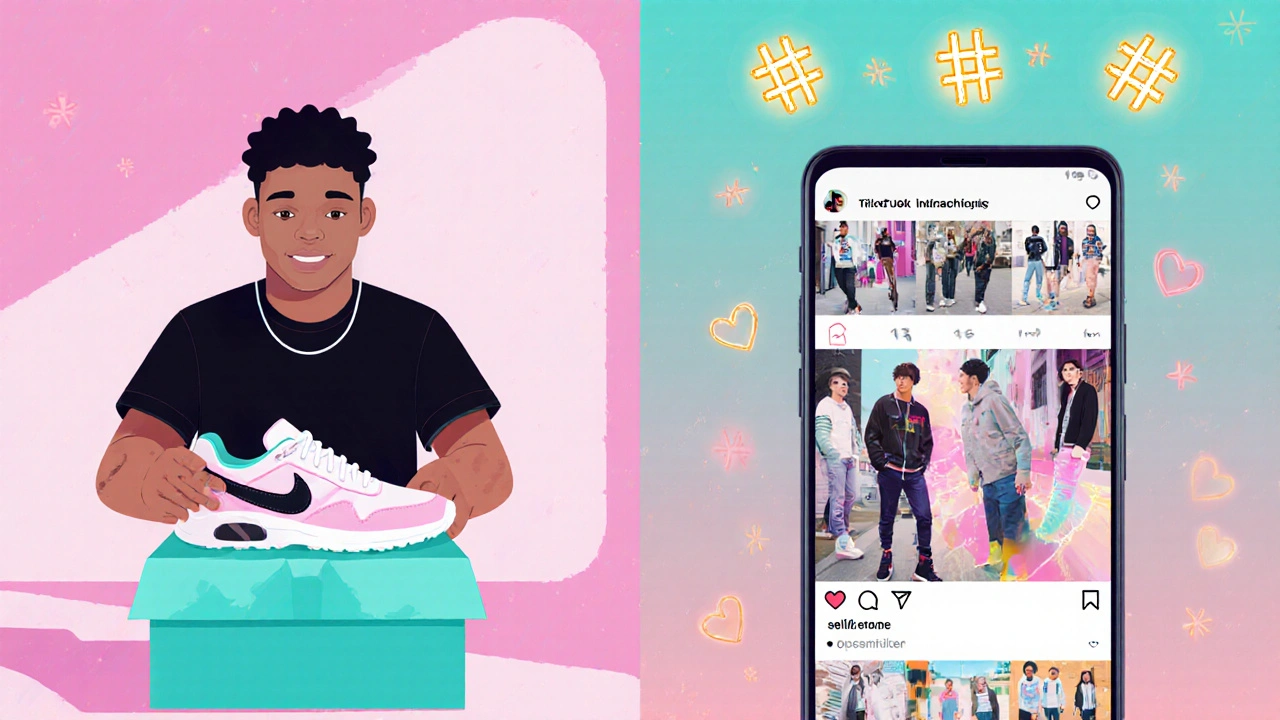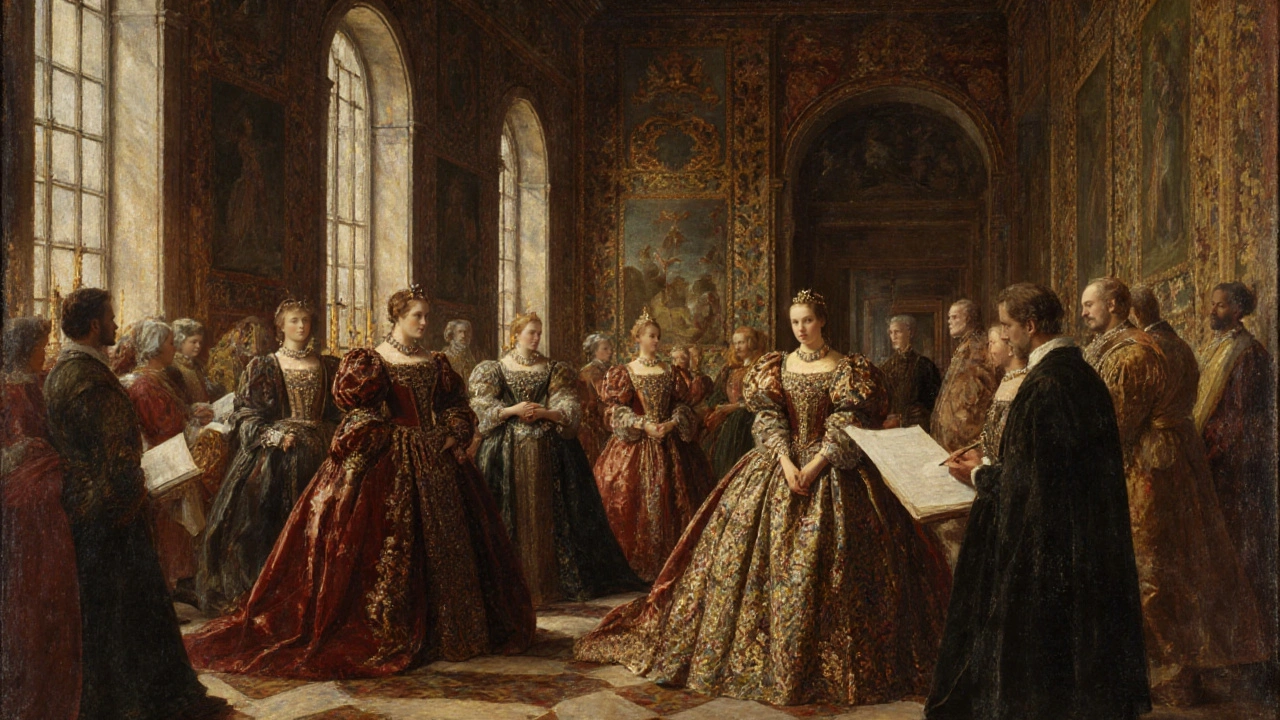Trend Lifespan Calculator
Estimate the typical lifespan and spread speed of a fashion trend based on its origin. This tool is based on historical fashion trend analysis.
How Trends Start
Each trend source has distinct characteristics that influence how quickly a style spreads and how long it remains popular. Select the source to see typical trend patterns.
Trend Velocity
Speed to Market
Very fast (days)
Trend Forecast
EstimatedDays
Months
Why Trends Work This Way
Understanding these patterns helps you spot emerging styles before they hit the mainstream. Celebrity trends spread fastest but fade quicker, while runway trends take longer to develop but often have more staying power.
As the article explains, "Today's trends usually begin at the intersection of three forces: celebrity endorsement, runway preview, and street adoption." This tool simplifies how these sources impact the trend lifecycle.
Ever wonder why a particular jacket, shoe, or color seems to pop up everywhere overnight? The answer lies in a long chain of cultural moments, power players, and media tricks that turn a single look into a full‑blown fashion trend. Below we break down the hidden history that makes today’s viral styles possible.
Quick Takeaways
- Fashion trends start when a new visual cue is adopted by a highly visible group (royalty, celebrities, designers, or subcultures).
- Historical milestones - from Renaissance court dress to 1960s mod - show how social change fuels style shifts.
- Media evolution - print, TV, internet, and social platforms - accelerates the spread of a trend.
- Today’s trend cycle is a blend of celebrity hype, runway previews, and street‑style grassroots movements.
- Spotting the next big thing means watching who wears what, where they wear it, and how quickly it’s shared.
What Exactly Is a Fashion Trend?
fashion trend is a recurring pattern of clothing, accessories, colors, or silhouettes that gains popularity across a broad audience for a limited period. Unlike personal style - which reflects an individual’s taste - a trend is a collective signal that tells the market what’s “in” right now.
Early Roots: From Royal Courts to the Middle Class
Before mass production, style was a marker of status. In 15th‑century Europe, royalty dictated what the elite wore. Sumptuary laws even tried to lock specific fabrics and colors to certain classes, proving that clothing was already a language of power.
The 17th‑century rise of the merchant class created a new consumer base hungry for the look of the aristocracy. Tailors began copying court silhouettes - think the puffed sleeves of LouisXIV - and selling them at lower prices. This was the first ‘trickle‑down’ effect, where an elite style filtered down to broader society.
Industrialization in the 19thcentury changed the game. Ready‑made clothing meant designers could produce dozens of identical pieces, and department stores like Selfridges turned window displays into miniature trend‑launch pads. A striking coat shown in a store window could instantly become a street‑level must‑have.

The Celebrity Explosion: Hollywood, Music, and Royalty
When cinema boomed in the 1920s, movie stars became the new fashion arbiters. celebrity wardrobes were photographed in glossy magazines, giving audiences a daily dose of style inspiration. Think of Clara Bow’s bob cut or AudreyHepburn’s little black dress - each sparked a wave of imitators.
Music icons amplified this effect. The Beatles’ collarless suits, David Bowie’s Ziggy Stardust jumpsuit, and Madonna’s lace gloves each sparked distinct trend cycles that spanned music videos, concerts, and fan wardrobes.
Royal influence never faded. Princess Diana’s off‑the‑shoulder gowns and the British royal family's coordinated looks have repeatedly reshaped global sales, proving that “royal endorsement” is still a powerful catalyst.
Runway Shows: Designers as Trend Architects
Fashion weeks in Paris, Milan, New York, and London turned the runway into a forecasting machine. Designers showcase collections months ahead, giving buyers, journalists, and influencers a preview of the upcoming runway aesthetic.
These shows aren’t just about clothes; they’re theatrical events that blend music, set design, and celebrity attendance. When a designer like AlexanderMcQueen stages a dramatic catwalk, the resulting visual language - be it dark romanticism or futuristic minimalism - often spills into mainstream retail.
Street Style and Subcultures: The Bottom‑Up Engine
Meanwhile, grassroots movements have always sparked counter‑trends that eventually dominate the market. The 1970s punk scene, with its ripped tees and safety‑pin accessories, forced high‑end brands to incorporate anarchy‑inspired details. Hip‑hop’s baggy jeans and oversized jackets in the 1990s moved from the Bronx to global retail shelves within a decade.
Today, street style is documented in real time on Instagram, TikTok, and fashion blogs. A single viral outfit posted by a street photographer can lead major brands to copy the look within weeks.
Media Amplification: From Magazines to Social Platforms
Print media, especially fashion magazines like Vogue, once held sway as the primary conduit for trend diffusion. A single cover story could launch a color palette or silhouette into the mainstream.
Television added speed. Shows like “Project Runway” gave viewers backstage access to design processes, turning viewers into trend participants.
The internet accelerated everything. Blogs, YouTube hauls, and Pinterest mood boards turned the discovery phase into an interactive experience. In the last decade, social media has become the fastest trend engine. A meme‑driven sneaker release can sell out in seconds, showing how digital buzz translates directly into purchase intent.

Modern Trend Cycle: How Trends Start Today
Today’s trends usually begin at the intersection of three forces:
- Celebrity endorsement - A red‑carpet dress or an influencer’s outfit post provides instant visibility.
- Runway preview - Designers tease key pieces months ahead, creating anticipation among buyers.
- Street adoption - Real‑world wearers remix high‑fashion looks, often adding personal twists that make the style more relatable.
Data analytics now inform each step. Brands monitor Instagram hashtags, Google Trends, and sales data to decide which runway looks to mass‑produce. Influencer marketing platforms match creators with emerging silhouettes, turning a niche look into a global purchase.
Comparison: Celebrity‑Driven vs. Runway‑Driven vs. Street‑Style‑Driven Trends
| Source | Speed to Market | Typical Audience | Longevity | Key Example |
|---|---|---|---|---|
| Celebrity | Very fast - days | Mass market, fans | Medium - 6‑12months | Rihanna’s Fenty sneakers |
| Runway | Moderate - months | Buyers, fashion press | Long - 12‑24months | Gucci’s 2023 floral prints |
| Street Style | Fast - weeks | Youth, subculture fans | Short - 3‑6months | Skate‑culture oversized tees |
Checklist: Spotting the Next Big Trend
- Identify a high‑visibility wearer (celebrity, influencer, designer).
- Look for repeated visual cues across multiple platforms (color, silhouette, accessory).
- Check the “share velocity” - how quickly the look spreads on Instagram/TikTok.
- See if retailers are already placing similar items in upcoming collections.
- Gauge cultural relevance - does the look tie into a larger social or political conversation?
Frequently Asked Questions
Why do celebrities have such a big impact on fashion?
Celebrities receive massive media exposure, and their personal brand often aligns with aspirational lifestyles. When they wear a piece, fans associate it with success, leading retailers to quickly stock similar items.
How do runway shows influence everyday clothing?
Runway collections preview the designer’s vision for the upcoming season. Buyers from major retailers attend these shows, select key pieces, and translate them into mass‑produced versions that appear in stores months later.
Can street style start a global trend?
Yes. When a niche look gains traction on platforms like TikTok, brands monitor the buzz and often release ready‑to‑wear versions to capitalize on the momentum.
What role does technology play in today’s trend cycles?
AI tools analyze hashtag usage, search queries, and sales data to predict which runway looks will resonate. Influencer platforms also use algorithms to match creators with emerging styles, speeding up the diffusion process.
How long does a typical fashion trend last?
Most trends have a life span of 6 to 18 months, though iconic moments (e.g., the little black dress) can persist for decades.


Fashion's evolution is like a never‑ending story, and this piece captures that spirit perfectly. From royal courts to Instagram feeds, every era adds its own splash of color. It's amazing how the same desire to be seen drives everything, whether you're a king or a TikTok star. Keep digging into those patterns, and you'll see why trends bounce back faster than ever. The more you understand the past, the better you can predict the next big wave. Stay curious and keep scrolling!
Thanks for the positive vibes! 😊 The way you highlighted the blend of optimism and history really resonates. It's exciting to see that enthusiasm applied to fashion cycles.
The article breaks down how trends start. It shows that celebs, designers, and street wear all play a part. Simple and clear.
I hear you, it's easy to feel overwhelmed by all the sources. Knowing that every piece fits into a bigger picture can help us stay grounded.
Honestly, the whole ‘royal to Instagram’ narrative feels over‑simplified.
I get where you're coming from, but remember that the royal influence still matters in subtle ways. Even today, a crown‑like accessory can spark a ripple through social media.
While the article is informative, it suffers from several stylistic inconsistencies. The opening paragraph contains unnecessary HTML tags that distract the reader. Moreover, the bullet points lack parallel structure, making the list feel disjointed. A more disciplined editorial approach would enhance clarity without sacrificing depth.
Great points in the previous comment I agree with the need for tighter editing and a clearer flow the piece could benefit from tighter headings and smoother transitions
The presented analysis is fundamentally flawed; it exhibits a superficial grasp of historical fashion dynamics. Its reliance on anecdotal evidence rather than rigorous scholarly sources undermines its credibility. Furthermore, the cursory treatment of socioeconomic factors reflects a negligent approach to academic standards. Such negligence is unacceptable in any serious discourse.
You know, I think there's a hidden agenda behind all this. Big brands probably feed the article to steer us toward buying more stuff, while they track our every click. It's like a data trap disguised as education.
The evolution of fashion is not merely a series of aesthetic choices, but a moral mirror reflecting the values and contradictions of each era.
When we celebrate the sparkle of royal courts, we must also acknowledge the oppressive hierarchies that those garments symbolized.
Similarly, the rapid rise of Instagram‑driven trends often masks the exploitative labor practices that underpin mass production.
Each time a celebrity dons a designer piece, the hidden cost is frequently borne by unseen workers in distant factories.
The allure of street‑style authenticity can obscure the commodification of subcultural identities for profit.
Thus, the cyclical nature of trends can perpetuate a cycle of consumption that disregards ethical considerations.
It is incumbent upon us, as informed observers, to interrogate not just the look, but the entire supply chain that makes it possible.
Historical precedents show that fashion has long been a tool of power, from sumptuary laws that reinforced class divisions to modern marketing campaigns that shape desire.
By recognizing this lineage, we gain the capacity to resist passive acceptance of every new fad.
Choosing to support sustainable, transparent brands becomes an act of resistance against the commodification of culture.
Moreover, educating ourselves about the origins of trends empowers us to make choices aligned with our ethical standards.
The responsibility does not lie solely with designers; consumers wield significant influence through collective demand.
When we collectively prioritize integrity over immediacy, the industry is forced to adapt.
In this way, the very mechanisms that once spread frivolous styles can be repurposed to promote accountability.
Let us therefore view fashion not as a shallow pastime, but as a profound societal barometer.
Only then can we transform the endless cycle of trend creation into a force for positive change.
I appreciate the depth of your analysis; it offers a valuable perspective that many overlook. Its thoroughness encourages thoughtful discussion.
This article is a shameless piece of clickbait masquerading as scholarship.
It strings together a mishmash of unrelated facts and pretends to offer insight.
The author clearly lacks any real understanding of fashion history, resorting to generic buzzwords.
Every paragraph is riddled with superficial jargon that serves no purpose beyond inflating word count.
The so‑called ‘trend lifespan calculator’ is a gimmick that adds zero value to the discourse.
Moreover, the lack of credible citations turns the entire work into an uninformed opinion.
It smuggles corporate propaganda under the guise of education, pushing brands without accountability.
The narrative is riddled with logical fallacies, presenting cause and effect where none exists.
Readers are insulted by the lazy structure and the overuse of HTML placeholders that disrupt flow.
The writer seems more interested in padding the article with tables than delivering substance.
Such a sloppy approach disrespects both the audience and the genuine scholars of fashion.
Anyone with a modicum of critical thinking can see through this nonsense instantly.
In short, this is a textbook example of content farms churning out meaningless material.
It contributes nothing to the conversation and only fuels misinformation.
I strongly advise skipping this piece and seeking out reputable sources instead.